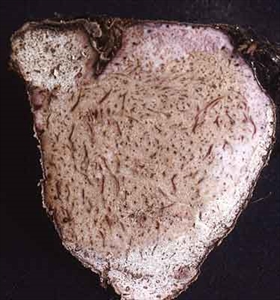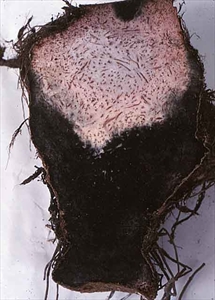Taro corm rots (post-harvest)
Pacific Pests, Pathogens, Weeds & Pesticides - Online edition
Pacific Pests, Pathogens, Weeds & Pesticides
Taro corm rots - post-harvest (179)
The following are the commonly recorded rots that develop in taro corms after harvest:
Athelia rolfsii (see Fact Sheet no. 11)
Lasiodiplodia (Botryodiplodia) theobromae
Pythium splendens
Phytophthora colocasiae (see Fact Sheet no. 14)
Erwinia species: Erwinia carotovora subsp. carotovora (see Fact Sheet nos. 101, 214, 289, 296); now renamed Pectobacterium carotovorum subsp. carotovorum, and Erwinia crysanthemi.
The fungi, Athelia rolfsii and Lasiodiplodia threobromae have a worldwide distribution; Pythium splendens and Phytophthora colocasiae (oomycetes, water moulds, not fungi) are also recorded worldwide in tropical and sub-tropical countries. In Oceania, Phytophthora colocasiae is present in Federated States of Micronesia, Guam, Northern Mariana Islands, Palau, Papua New Guinea, Samoa and Solomon Islands. Erwinia species also occur worldwide.
The fungi attack many plants. Athelia rolfsii attacks beans, carrots, cucumber, capsicum, peanut (see Fact Sheet no. 11), sweetpotato, and tomato. Lasiodiplodia theobromae is found worldwide, and is principally a wound pathogen, infecting underground and aboveground plant parts.
Pythium splendens is associated with seed rot, root rot, and seedling damping-off (see Fact Sheet no. 47). It is found attacking the roots of beans, cucumber, papaya, pineapple, sweetpotato, tobacco, and many more. Phytophthora colocasiae causes a leaf blight on taro and giant taro (see Fact Sheet no. 14).
Erwinia species are bacteria with a wide host range causing soft rots. Erwinia carotovora pv. carotovora causes soft wet rots of e.g., carrots, cucurbits, Chinese cabbages (see Fact Sheet no. 101), lettuce (see Fact Sheet no. 289), potato tubers (black leg disease) (see Fact Sheet no. 296), tobacco, and others. Erwinia chrysanthemi causes soft rots in many kinds of fleshy vegetables, especially when wounded.
The oomycetes, Pythium and Phytophthora, infect corms through wounds made after harvest, but how this occurs is not known. Development of the rots is very rapid, and corms can be completely decayed within 4-10 days depending on their size and the number of infections.
Pythium rots are white, dry and crumbling, often starting at the bottom of the corm (Photo 1). There is a sharply defined, irregular boundary between the areas of rots and healthy parts. In front of the rot margin, a wide light reddish-brown area of firm healthy tissue is often present.
Phytophthora rots are light brown and firm (Photos 2&3)
Athelia rots are shallow and occur around the place where suckers have been removed, although occasionally the rots penetrate deeply into the corm. The rots show the thick white strands of the fungus growing out from the rot when corms are placed at high humidity for 24 hours (Photos 1&2.
Lasiodiplodia is mostly a wound pathogen associated with blights, dieback, damping-off and storage rots of all kinds of plants (Photo 4). It is often isolated from decayed corms behind the rots caused by Pythium and Phytophthora . The rots are white at first and later turn black and have a distinctive unpleasant sour smell.
Erwinia rots are often strong smelling white soft rots (Photo 5). They have been found in corms that were harvested and stored in leaf-lined soil pits, or in corms kept in plastic bags.
The damage done at harvest when the "tops" and suckers are removed allows the entry of fungi, oomycetes and bacteria. The damage done by the two oomycetes is extensive and rapid; often the corms are entirely destroyed within 10 days. Invasion by Lasiodiplodia is also rapid, but often the fungus invades corms following colonisation by Pythium and Phytophthora. Without initial infection by Pythium and Phytophthora, colonisation by Lasiodiplodia still occurs, but usually later when the corms begin to shrivel with loss of water. Athelia causes minor damage; the rots are much slower to develop compared to those of the other fungi and the two oomycetes. Erwinia rots can be very destructive, especially in corms placed at high humidity in plastic bags.
It is difficult to detect any of the rots, except those of Lasiodiplodia, unless the corms are cut open. Lasiodiplodia can be detected as it gives the corms a sour smell, a spongy feel and, often, black powdery spore masses occur in patches on the surface of the corm.
Cut the corms in half vertically after about 7 days after harvest and storage at normal daily temperatures and humidity. Look for the white, crumbly rot of Pythium, the firm light brown rot of Phytophthora, the shallow pink rot of Athelia, and the black rot of Lasiodiplodia, usually behind rots of Pythium and Phytophthora. Erwinia rots are usually very characteristic: they have a foul smell, and are soft. Look for the cottony growth of Pythium and Athelia when the corms are held inside a plastic bag overnight.
CULTURAL CONTROL
Storage life of taro corms can be extended by doing the following:
Harvest the corms leaving the 'tops' and suckers attached, but remove the leaves, trimming the leaf stalks to about 10 cm. Remove large soil clods, but do not wash the corms. Place the corms in a soil pit lined with e.g., banana leaves. The pit should be situated in a shaded, well-drained location. Cover with more banana leaves. This is a traditional practice in Sikaiana, Solomon Islands. The corms will remain in a good condition with an acceptable taste for up to 4 weeks.
The corms stay active, and the leaves continue to grow. Presumably, leaving the 'tops' and suckers in place reduces wounding and the chance of infection.
There are variations on this technique if growers want to market taro locally or overseas:
- Place corms, with 'tops' and suckers attached in plastic bags. The high humidity allows the corms to grow and this prevents most fungal and oomycete rots from developing in a similar way to those in soil pits. However, Erwinia rots can be a problem, affecting about 10% of the corms.
- Ship the corms in plastic-lined cardboard boxes to prevent damage to the corms in transit.
Both these methods can be improved if the corms are washed and given a dip in 1% sodium hypochlorite (household bleach) for 2 minutes. A drawback of this method is that the surface colour of the corms becomes lighter than normal, which may concern some consumers. Lower concentrations of bleach or shorter treatments may be effective.
CHEMICAL CONTROL
Other than the use of bleach, chemicals cannot be recommended for the control of storage rots; there is not enough information to show that they are cost-effective, or safe to human health. Unless plastic bags are used, the corms will always shrink and crack after treatment allowing infections of Lasiodiplodia. Keeping them in plastic bags is likely to be sufficient. If chemicals were to be used, checks would be needed to determine if residues were within internationally acceptable limits.
AUTHOR Grahame Jackson
Information from and from Biosecurity Australia (2011) Review of import conditions for fresh taro corms. Biosecurity Australia, Canberra. (https://www.agriculture.gov.au/sites/default/files/sitecollectiondocuments/ba/plant/2011/taro/Review_of_Import_Conditions_for_Fresh_Taro_Corms_clean.pdf); and from Carmichael A, et al. (2008) TaroPest: an illustrated guide to pests and diseases of taro in the South Pacific. ACIAR Monograph No. 132, 76 pp. (https://lrd.spc.int/about-lrd/lrd-project-partners/taropest).
Produced with support from the Australian Centre for International Agricultural Research under project PC/2010/090: Strengthening integrated crop management research in the Pacific Islands in support of sustainable intensification of high-value crop production, implemented by the University of Queensland and the Secretariat of the Pacific Community.








